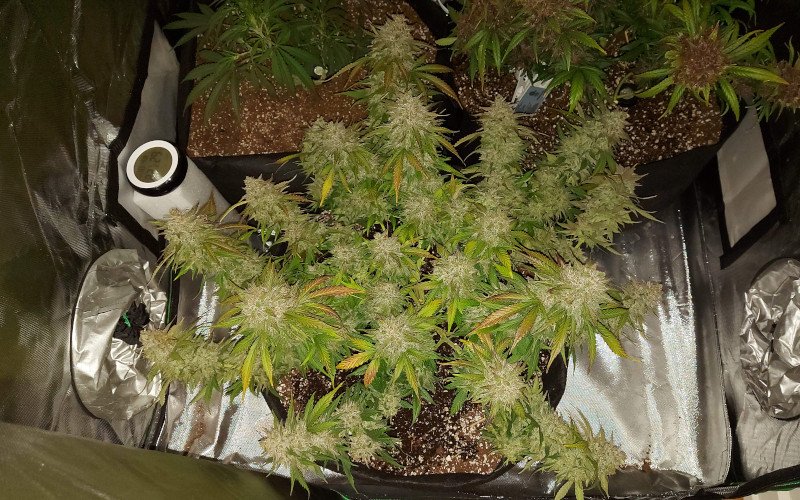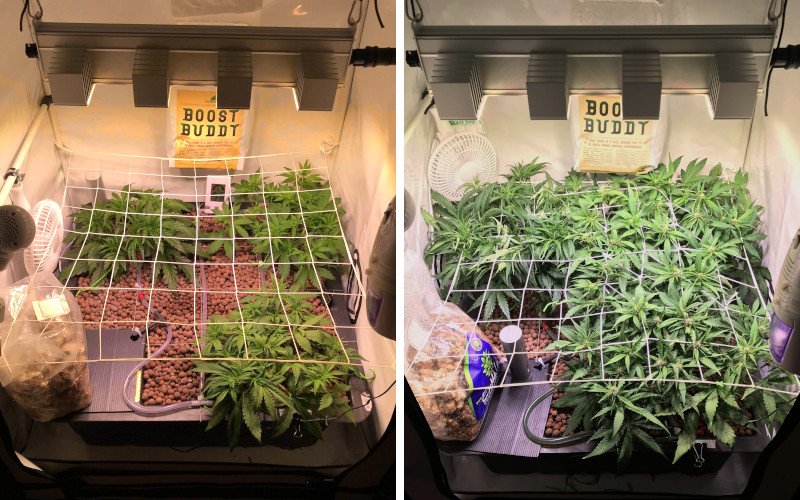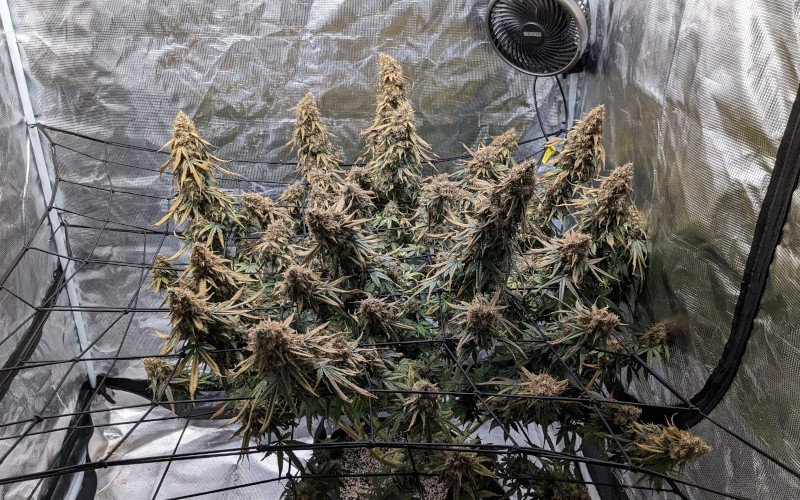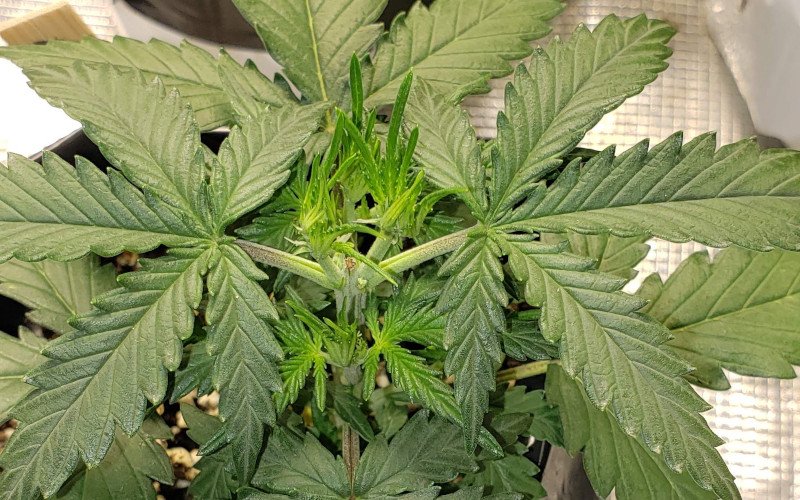Cannabis Training Techniques: An Overview

Training doesn’t have to be that hardcore. ©Growdiaries Photo: canamatoes
Simply put, cannabis training means manipulating a plant’s canopy to give it a more manageable shape. For example, we can bend and tie down the main stem or the longest side branches or even cut their tops. It all falls under the definition of training.
Why train at all?
Cannabis plants are unlike your mother’s house plants – they grow very fast. So, you often need to restrict their growth to make them fit the limited grow space. Another concern is the efficient use of lights indoors. Even the most powerful of them have a limited effective range, and the best course of action is to have every plant top be at the same distance from the grow light. Proper training takes care of that (as it did for Purple Lemonade Auto in the photo below – thanks to training, it grew a large number of equally fat and dense top buds).

The same distance from the light equals the same size of colas. ©Growdiaries Photo: Sider79
We’ve given you two very real reasons to employ some kind of training in your first grow, but frankly, there are less rational reasons, too. Cannabis is often perceived as a magical plant, and there’s a lot of magical thinking surrounding its cultivation. Simply put, beginners don’t believe they can grow potent stuff unless they make some extraordinary effort, like training or using some fancy overpriced nutrients, etc.
It’s not really true. The potency of cannabis depends on its genetics and general good practices of cultivation and not on some fancy tricks that pros hide from those uninitiated. Having said that, cannabis training techniques are something you should definitely master – they are very helpful and will take both the yields and the quality of the final product to the next level.
Cannabis Plant Training Techniques
On the following list, the simplest and least risky techniques will come first, followed by those that are more difficult to master and can lead to trouble if you don’t know exactly what you’re doing. So, if you’re a newbie, take your time mastering them one by one.
Low-Stress Training (LST)
LST (being low-stress) won’t kill even a sickly or stunted little guy, though as with any type of training, it should better be performed on a vigorous, fast-growing plant. Simply bend the main stalk or the fastest growing branch and tie it down with twine or wire. This will expose the lower part of the plant to more light, and besides, it breaks the so-called apical dominance, so that the plant redirects its energy from the former (one) top to new (multiple) tops.
In the photos below, you can see two Gorilla Cookies Auto plants that were just low-stress trained in veg yet went on to produce record-setting yields. Note how the stem was secured at the base before it was bent and tied down.

LST in action. ©Growdiaries Photo: crystal_garden_0 & NorthernAutos
LST is the most powerful form of controlling the plant’s height. Moreover, it’s consistently one of the most efficient ways of increasing yields, at least indoors. It requires some time and effort but is very easy to master. The worst thing that could happen with LST is when a branch snaps when you bend it down too eagerly.
Screen of Green (SCROG)
While LST is more than enough for shaping a flat canopy (the one that promises the most generous yields indoors), some growers think having all those ties is too messy and install a horizontal ScrOG net to curb their plant’s vertical growth and spread the canopy across the whole available area. The following photograph from an LSD-25 Auto photo grow shows what it can look like.

ScrOG is very convenient in hydroponics, but presents challenges if the garden is watered manually. ©Growdiaries Photo: Salokin
If you choose Screen of Green, be prepared to start your morning by tucking all the tops under the mesh. By the next morning, they’ll be raising their stubborn little heads above the net again, and you’ll need to repeat the procedure. This will be your daily chore in late veg and maybe in the first week of flowering. When the budding really kicks in, you’ll let the tops grow above the net and toward light.
The beauty of ScrOG is that the net provides support for the buds when they start filling out and make the branches bend under their weight as they clearly do in the Gorilla Auto photo below.

These heavy colas need all the support they can get. ©Growdiaries Photo: accela_resonance
Screen of Green has its drawbacks, too: it’s labor-intensive, it makes the space below the mesh very crowded when you try to water for example, and it doesn’t allow you to easily take your plants out of the grow tent when you need to.
High-Stress Training (HST) Techniques Explained
High-stress training techniques are those that result in considerable stress for plants. Usually, they involve things like cutting, crushing, or breaking stems and branches. When they say ‘HST’, most weed growers mean topping, FIMing, and mainlining (they all will be explained below), but supercropping (when you crush and bend a stem or branch) is definitely a high-stress procedure as well.
Pruning, defoliation, and lollipopping, although they subject plants to considerable stress, aren’t strictly training; they are a different kind of canopy-management techniques.
Topping
Topping means cutting the very top of either the main stem or a side branch. The rationale here is that when the main growing point is destroyed like this, the plant has no other way to keep growing but to redirect its energy to the lower growth. At the very least, you’ll get two new shoots instead of one – from the uppermost node that wasn’t cut off. However, all other nodes down the stem get an impulse to grow too, eventually turning your slender plant into a wide multi-branch bush.
The Girl Scout Cookies Auto in the picture below had well-developed nodes from an early age, and topping only enhanced its tendency to bush out.

Once topped, the plant focuses on side branches. ©Growdiaries Photo: BB_US
Topping is a great way to get multiple colas of the same size and texture instead of just one, but it doesn’t control the height of the plant as efficiently as you’d think. To make your garden low profile, you’ll have to extend the topping with some form of LST.
With photoperiod plants, you can perform as many toppings as you need – until you’re satisfied with the girth of the plant and the number of branches on it. With autoflowers, the topping of the central stem is done only once (if at all) and only on a robust, healthy plant.
FIMing
FIMing is a form of topping. Legend says that a grower exclaimed “Fuck, I missed!” when he botched an attempt to top his weed in a normal way. However, his mistake led to a pleasant surprise – the mangled top recovered and turned into even more tops than with normal topping. When FIMing, you don’t cut below the top node but right through it. Look at the photo below where a Zkittlez Auto plant was FIMed just right.

The FIMed top, though mangled, continues to grow. ©Growdiaries Photo: martiniii
A FIMed top will stop growing at first, passing the baton to lower nodes, but after a while, it will recover and join in on the growth. You can try both regular, clean topping and FIM and see what works best for you.
Mainlining
Mainlining is a plant training technique that combines topping and LST. While other forms of training can be very ad hoc, mainlining is performed according to a plan and on a set schedule. It starts with cutting the main top on a very young plant and leaving just two side shoots. Then, each of these two is topped to make four; then, four turn into eight; then sixteen. Theoretically, you can keep topping, but most gardeners would stop at 16.
Main-lining is sometimes performed on autoflowers too (when they’re strong and healthy), but their vegetative period is much shorter than in photoperiod strains, so you should probably stop at 8 main branches – see a Strawberry Gorilla Auto in the photos below.

A mainlined autoflower. ©Growdiaries Photo: CURATI_DA_SOLO
Each opposing pair of branches is spread in different directions and secured with twine or wire to make a perfectly flat canopy shape, not unlike a sundial. Cannabis tends to grow many secondary branches, but with mainlining they are cut off, as this method calls for a highly organized, symmetrical structure.
The advantage of mainlining is that the procedure is standardized – with predefined steps that you take at a set moment of time, so beginners play no guessing games and don’t need to rely on their intuition (which they don’t have yet). The disadvantage of mainlining is that it involves a lot of stress and extends the vegetative stage considerably.
Pruning, Defoliation, and Lollipopping
These three are different forms of thinning the canopy and can be beneficial when the foliage is too dense to allow the light to penetrate all the way down the stem and inside the canopy. They can also facilitate airflow – an especially important consideration when there’s risk of mold because of stale air.
The Strawberry Pie Auto in the pics below may not look like it needed a haircut, but it’s all context-dependent. Maybe the grower’s light was too weak, or he was afraid of fungal infections later in the cycle? Anyway, he opted for a thin, open-structured canopy.

An open bush structure facilitates light penetration. ©Growdiaries Photo: DrGreen13
Some growers get carried away with scissor work. We suggest always having a reason why you remove a particular leaf, bud site, or a whole branch, such as “This leaf has to go because it shadows the lower bud site” or “This branch has to go because it’s too low on the bush and too far from the light”, etc.
While pruning and defoliation should be selective like this, lollipopping usually involves stripping everything in the lowermost quarter/third of the canopy (that depends on the power of your grow light). In ScrOG, people usually remove everything below the mesh, leaving only naked branches.
Super Cropping
It isn’t the most self-evident term, but super cropping simply means crushing and softening the tissues of a branch in the place where you want to bend it. Growers do it when the plant is already mature and its branches are woody – usually after the flowering stretch has gotten out of hand and the longest branches threaten to touch the light. (See the Sativa-leaning Californian Snow Auto in the photo below.)

Supercropping was the only way of dealing with this ‘hotshot’ branch. ©Growdiaries Photo: MEDICAT
Besides being a last-minute solution of keeping the height in check, the name ‘super cropping’ also hints at the method’s ability to boost yields. Often, it really does as the crushed place soon heals and turns into a ‘knuckle’, which, like a large-diameter piece of piping, can transport even more nutrients and water to the flowers above.
In Conclusion
We’ve provided a bird’s-eye view of the different training techniques available to the weed grower. Some of them are less risky, others are more risky, but all can be extremely beneficial when done in the right context and for the right reasons. Just don’t think that you should use each one of them at once or that your cannabis won’t grow properly without them. Keep it simple for the first couple of grows and learn things as you move along. Happy growing!
The photographs we use in this articles are from growdiaries.com, the largest online community of weed cultivators.

